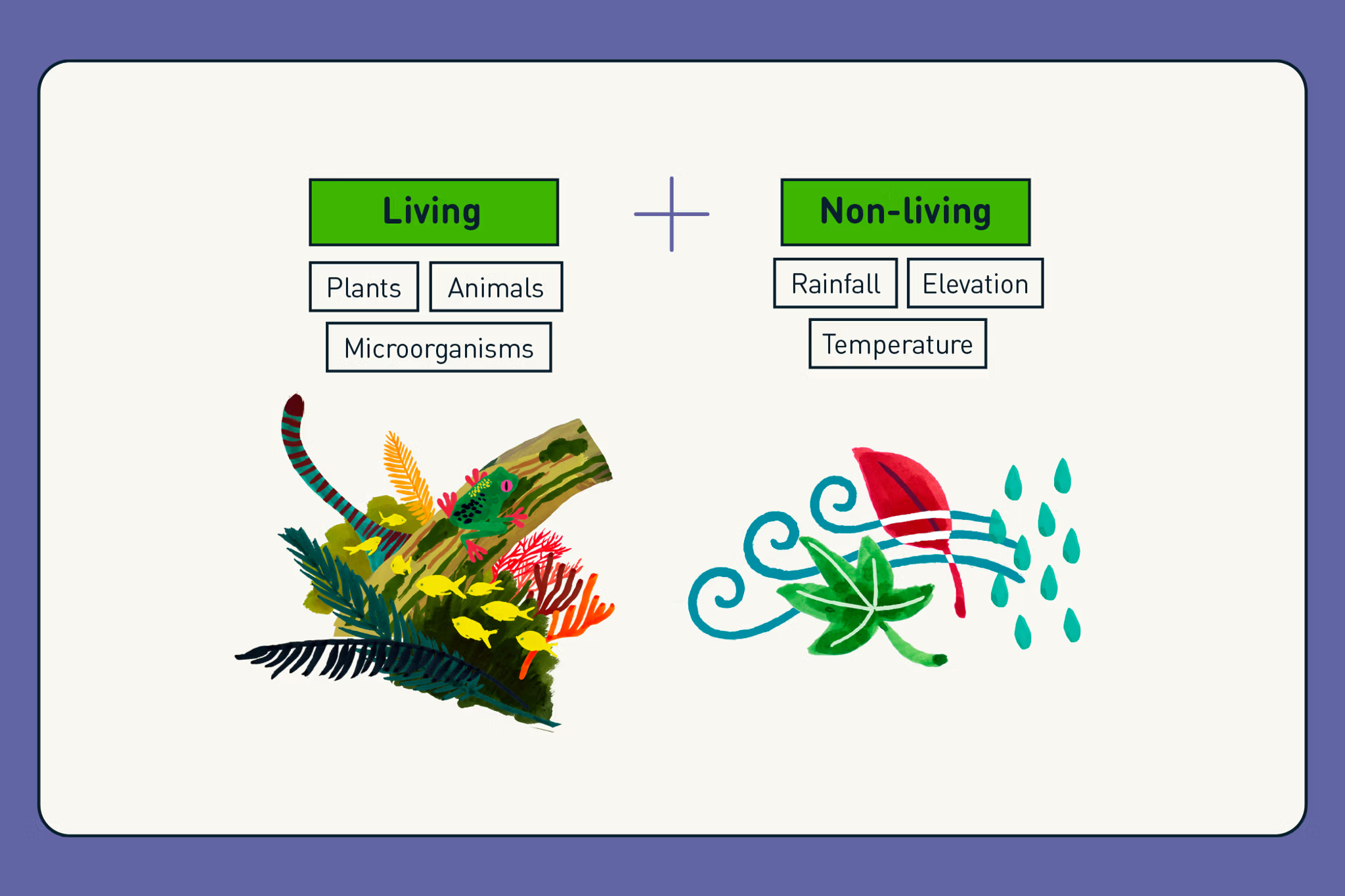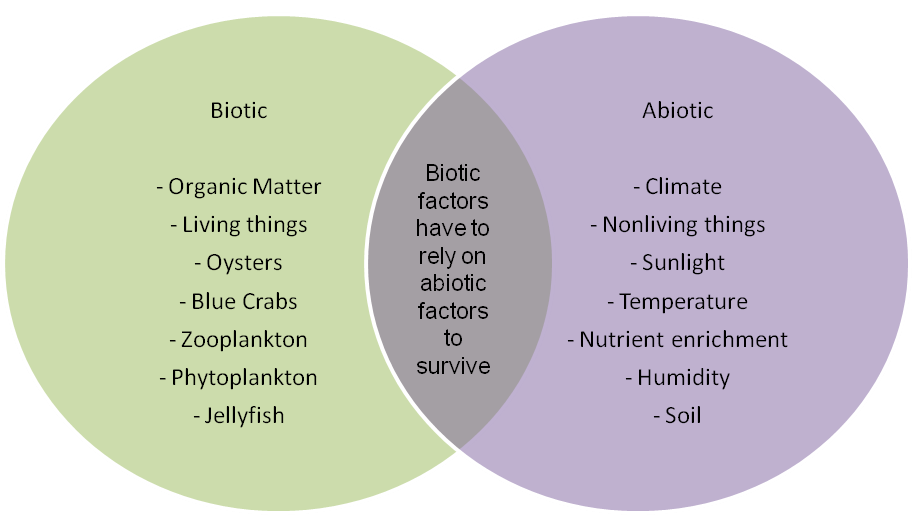Topic the nonliving parts of an ecosystem: Discover the vital role of the nonliving parts of an ecosystem, essential abiotic factors that shape the lives of all organisms and sustain biodiversity.
Table of Content
- What are the nonliving parts of an ecosystem?
- Overview of Abiotic Factors
- Importance of Abiotic Factors in Ecosystems
- Types of Abiotic Factors
- Role of Water and Soil
- Effects of Sunlight and Temperature
- YOUTUBE: Living and Non-living Parts of an Ecosystem
- Chemical Elements and Nutrients
- Abiotic Stress on Ecosystems
- Interaction Between Abiotic and Biotic Components
- Human Impact on Abiotic Factors
- Conservation and Management of Abiotic Resources
What are the nonliving parts of an ecosystem?
The nonliving parts of an ecosystem, also known as abiotic factors, are the components of an environment that are not alive. These factors play a crucial role in shaping the ecosystem and influencing the organisms that inhabit it.
- 1. Atmosphere: The gases present in the air, such as oxygen, carbon dioxide, and nitrogen, contribute to the atmospheric conditions of an ecosystem.
- 2. Water: Bodies of water, including rivers, lakes, oceans, and groundwater, provide habitats for aquatic organisms and are important for various ecosystem processes.
- 3. Soil: The soil composition, including its texture, nutrient content, and pH level, affects the growth and survival of plants and other organisms in the ecosystem.
- 4. Temperature: The average temperature of an ecosystem influences the types of organisms that can thrive in that environment.
- 5. Light: Sunlight is an essential abiotic factor as it provides energy for photosynthesis, which is the process by which plants convert sunlight into food.
- 6. Geography: The physical features of the land, such as mountains, valleys, and plains, create diverse habitats for different organisms.
- 7. Chemical composition: The presence of various chemicals, including minerals and pollutants, can impact the health and functioning of organisms within the ecosystem.
Together, these nonliving factors interact with the living components of an ecosystem to create a complex and interconnected web of life.
READ MORE:
Overview of Abiotic Factors
Abiotic factors, the nonliving elements of ecosystems, play a crucial role in shaping the natural world. These factors include a broad range of physical and chemical aspects of an environment, influencing the structure and function of ecosystems. Understanding these elements is essential for grasping how ecosystems operate and how various forms of life adapt to their habitats.
- Temperature: A key determinant of biogeographical distribution, affecting metabolic rates of organisms.
- Water: Essential for life, influencing species distribution, productivity, and habitat structure.
- Light: Drives photosynthesis, determining energy availability and influencing plant growth patterns.
- Soil and Nutrients: Support plant growth and affect the distribution and health of terrestrial ecosystems.
- Wind: Affects plant morphology, seed dispersal, and microclimate conditions.
- pH and Salinity: Influence species composition, especially in aquatic ecosystems.
These abiotic components interact with biotic factors (living components) to create the dynamic systems that sustain life on Earth. By modulating conditions such as temperature and water availability, abiotic factors can influence the survival, growth, and reproduction of organisms, ultimately shaping ecosystems" characteristics and productivity.

Importance of Abiotic Factors in Ecosystems
Abiotic factors are the bedrock of ecosystems, providing the nonliving foundation that supports and shapes the living world. These factors are critical in determining the structure, function, and productivity of ecosystems. They directly influence the lives of organisms, from microscopic bacteria to large mammals, by defining their physical environment and the resources available to them.
- Regulation of Biological Processes: Temperature and sunlight regulate photosynthesis in plants, which is the primary source of energy for most ecosystems.
- Water Availability: Determines the survival of organisms, influencing where plants and animals can live, and affecting their reproductive strategies.
- Soil Composition: Influences the types of plants that can grow, which in turn supports various animal species through the food web.
- Nutrient Cycling: Essential elements like nitrogen and phosphorus are cycled through ecosystems, with abiotic factors influencing their availability to living organisms.
- Habitat Formation: Physical features such as rocks, terrain, and bodies of water create habitats for different species, shaping biodiversity.
Understanding the importance of abiotic factors helps us appreciate the delicate balance of ecosystems and the critical role these nonliving components play in sustaining life. By influencing everything from the distribution of species to the timing of migration and reproduction, abiotic factors are integral to the health and stability of our planet"s diverse habitats.
Types of Abiotic Factors
Abiotic factors are the physical and chemical components that shape ecosystems. These factors can be broadly categorized into climatic, edaphic (soil-related), and social factors, each playing a unique role in the environment. Understanding these types is crucial for studying ecosystem dynamics and management.
- Climatic Factors: These include temperature, light, humidity, and atmospheric conditions that significantly influence living conditions.
- Edaphic Factors: Soil characteristics such as texture, composition, pH, and moisture content fall under this category, directly affecting plant growth and the distribution of terrestrial life.
- Social Factors: Human activities and land use practices that alter the natural environment, impacting the availability and quality of water and land resources.
Beyond these categories, specific abiotic factors like water availability, sunlight, air, and nutrients are fundamental to all ecosystems, determining the types of organisms that can thrive in a particular environment. Recognizing the diversity of abiotic factors helps in the conservation and sustainable management of natural habitats.

Role of Water and Soil
Water and soil are foundational abiotic factors in ecosystems, each playing unique, vital roles in supporting life. These elements not only provide the necessary conditions for plant and animal life but also contribute to the regulation of environmental processes that maintain ecosystem health.
- Water"s Role: Essential for all living organisms, water acts as a solvent, medium for chemical reactions, and transport system within ecosystems. It regulates temperature, facilitates nutrient uptake in plants, and supports aquatic habitats.
- Soil"s Role: Soil supports plant life by providing nutrients, water, oxygen, and a medium for root systems. It plays a crucial role in cycling carbon, nitrogen, and other essential nutrients. Soil"s structure and composition influence the distribution of ecosystems and biodiversity.
Together, water and soil form the basis of terrestrial and aquatic ecosystems, influencing climate regulation, water filtration, and the carbon cycle. Their conservation is critical for sustainable ecosystem functioning and biodiversity.
- Water Cycle Integration: Water cycles through ecosystems, connecting atmospheric, terrestrial, and aquatic environments.
- Soil Health and Fertility: Soil quality determines plant health and productivity, affecting food chains and ecosystem services.
The interdependence of water and soil underlines the importance of these abiotic factors in ecosystem resilience, productivity, and stability. Protecting these resources is essential for maintaining ecosystem health and ensuring the sustainability of life on Earth.
Effects of Sunlight and Temperature
Sunlight and temperature are pivotal abiotic factors in ecosystems, driving the processes that support life. Sunlight is the primary energy source for photosynthesis, enabling plants to produce food and oxygen, while temperature regulates the physical and biological activities of organisms.
- Sunlight: Fuels photosynthesis, the process by which plants convert light energy into chemical energy, sustaining the food web.
- Temperature: Influences metabolic rates of organisms, distribution of species, and timing of biological processes like migration and reproduction.
The balance of sunlight and temperature is crucial for ecosystem health. Changes in these factors can have far-reaching effects on biodiversity, species distribution, and ecosystem services. For instance, increased sunlight can enhance plant growth but also increase evaporation and soil dryness, affecting water availability. Similarly, rising temperatures can extend growing seasons in some regions but also exacerbate droughts and disrupt species interactions.
- Impact on Plant Growth: Sunlight intensity and duration affect photosynthesis rates and plant development.
- Climate Regulation: Temperature and sunlight patterns influence global and local climates, affecting weather conditions and habitat suitability.
Understanding the effects of sunlight and temperature on ecosystems is essential for predicting responses to climate change, managing natural resources, and conserving biodiversity. These factors underscore the interconnectedness of abiotic and biotic components in sustaining life on Earth.

Living and Non-living Parts of an Ecosystem
Discover the captivating wonders of the nonliving world! Explore the mesmerizing realm of inanimate objects and witness their extraordinary beauty and significance in this enlightening video that will change the way you perceive the world around you.
What is an Ecosystem? Populations, Communities, Abiotic & Biotic Factors
Step into the enchanting realm of the ecosystem and marvel at the intricate web of life that exists within it. This awe-inspiring video will take you on a journey through diverse habitats, allowing you to witness the delicate balance and interdependence of all living organisms.
Chemical Elements and Nutrients
Chemical elements and nutrients are crucial abiotic components that play a significant role in ecosystem dynamics. These elements are involved in various biogeochemical cycles, such as the carbon, nitrogen, and phosphorus cycles, which are essential for life processes.
- Carbon: A key element in organic molecules, carbon is central to the energy flow within ecosystems through the process of photosynthesis and respiration.
- Nitrogen: Essential for the synthesis of proteins and nucleic acids, nitrogen is a critical component of all living organisms and is cycled through ecosystems in various forms.
- Phosphorus: Vital for cell function, phosphorus plays a key role in energy transfer and the structure of cellular membranes.
- Oxygen: Necessary for respiration, oxygen is a fundamental element for most life forms.
- Potassium, Calcium, and Magnesium: Important for plant growth, these nutrients contribute to various physiological functions.
These elements are transferred between the physical environment and living organisms, facilitating critical processes such as growth, reproduction, and decomposition. The availability of these nutrients can significantly affect ecosystem productivity and health.
- Role in Plant Nutrition: Essential nutrients support plant growth, affecting the structure and biodiversity of ecosystems.
- Impact on Aquatic Systems: Nutrient levels influence water quality, affecting aquatic life and water resources.
Managing the balance of these chemical elements and nutrients is crucial for maintaining ecosystem integrity and preventing issues such as eutrophication in aquatic environments.
Abiotic Stress on Ecosystems
Abiotic stress refers to the negative impacts of nonliving environmental factors on ecosystems and the organisms within them. These stresses can include extreme temperatures, drought, flooding, salinity, and pollution, each affecting ecosystems in distinct ways.
- Temperature Extremes: High or low temperatures can limit the survival, growth, and reproduction of organisms, leading to shifts in species distribution and ecosystem dynamics.
- Drought: Reduces water availability, affecting plant growth and the animals that rely on them for food and habitat, leading to decreased biodiversity.
- Flooding: Alters habitats, disrupts plant and animal communities, and can lead to soil erosion and nutrient leaching.
- Salinity: Affects the ability of plants to take up water, leading to reduced growth and productivity, impacting agricultural lands and natural ecosystems.
- Pollution: Contaminates air, water, and soil, affecting the health and survival of all living organisms within an ecosystem.
Abiotic stressors often interact with biotic factors (living components of an ecosystem) to compound their effects, making ecosystems more vulnerable to degradation and loss of biodiversity. Understanding and mitigating the impacts of abiotic stress is crucial for conservation efforts and ensuring ecosystem resilience in the face of environmental changes.

Interaction Between Abiotic and Biotic Components
The intricate balance of an ecosystem is maintained through the constant interaction between its abiotic (nonliving) and biotic (living) components. These interactions form the foundation of ecological systems, influencing the survival, growth, and reproduction of organisms.
- Photosynthesis: Plants, algae, and certain bacteria use sunlight (abiotic factor) to convert carbon dioxide and water into oxygen and glucose, a process that is fundamental for the energy flow in ecosystems.
- Nutrient Cycling: Abiotic elements like nitrogen and phosphorus are assimilated by plants from the soil and then passed through the food web to animals and decomposers, linking the inorganic and organic components of ecosystems.
- Habitat Formation: Physical features such as water bodies, soil composition, and topography (abiotic factors) determine the types of habitats available for various organisms (biotic factors).
- Climate Regulation: The presence and activities of living organisms can influence local and global climates, which in turn affect the conditions of abiotic components like temperature and moisture levels.
These interactions highlight the dependency of living organisms on abiotic factors for resources like light, water, and nutrients, while also showcasing how biotic activities can modify abiotic conditions, creating a dynamic, interconnected system. Understanding these interactions is crucial for conservation efforts and the sustainable management of ecosystems.
Human Impact on Abiotic Factors
Human activities have profoundly impacted abiotic factors within ecosystems, often leading to significant environmental changes. These impacts can alter the fundamental conditions necessary for ecosystems to function and sustain life.
- Climate Change: Emissions of greenhouse gases from industrial activities have led to global warming, altering temperature and precipitation patterns worldwide.
- Pollution: Air, water, and soil pollution from chemicals, plastics, and other waste materials degrade the quality of abiotic components, affecting the health of ecosystems.
- Land Use Changes: Deforestation, urbanization, and agriculture transform landscapes, affecting soil composition, water cycles, and local climates.
- Water Extraction: Overuse of water resources for agriculture and industry reduces the availability of fresh water, impacting aquatic and terrestrial habitats.
- Soil Degradation: Practices such as overgrazing, use of chemical fertilizers, and deforestation lead to soil erosion, loss of fertility, and desertification.
These human-induced changes to abiotic factors not only threaten biodiversity and ecosystem services but also challenge our ability to adapt to a rapidly changing environment. Mitigating these impacts requires sustainable management practices and global conservation efforts.

READ MORE:
Conservation and Management of Abiotic Resources
Conservation and management of abiotic resources are vital for sustaining ecosystems and the services they provide. Effective strategies are needed to preserve these nonliving components, ensuring a balanced and healthy environment.
- Water Conservation: Implementing practices such as rainwater harvesting, sustainable irrigation, and reducing water pollution to maintain the quality and availability of freshwater resources.
- Soil Management: Employing soil conservation techniques like contour plowing, terracing, and organic farming to prevent erosion, maintain soil fertility, and enhance carbon sequestration.
- Air Quality Control: Reducing air pollution through cleaner energy sources, emission controls, and forestation efforts to improve air quality and combat climate change.
- Climate Change Mitigation: Adopting renewable energy, enhancing energy efficiency, and developing green infrastructure to reduce greenhouse gas emissions and mitigate climate change impacts.
- Sustainable Land Use: Promoting land use planning and conservation zoning to protect natural habitats, preserve biodiversity, and maintain ecosystem services.
These actions, combined with monitoring and research, can help manage the impact of human activities on abiotic resources. By prioritizing the conservation of water, soil, and air, we can ensure the resilience and sustainability of ecosystems for future generations.
Exploring the nonliving parts of an ecosystem unveils the intricate balance of nature, highlighting the essential role abiotic factors play in sustaining life and ensuring ecosystem resilience and sustainability for future generations.







